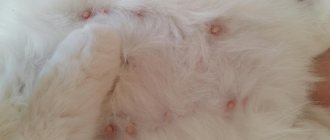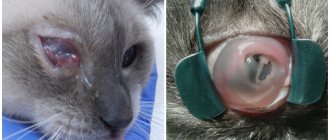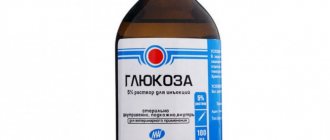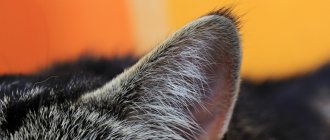The anal glands in cats are small organs located around the anus. Their main task is to secrete a special thick secretion that has a pungent and unpleasant odor.
When the paraanal glands become inflamed, the inner part of the tail becomes thick. This organ is designed to secrete a substance that the cat uses to mark territory or release when frightened. Many animals cope with getting rid of this fluid on their own, while others need the help of the owner.
When do cats and dogs need to have their anal glands cleaned?
Usually these glands are completely cleared when stool is released. This is a natural process and there is no need to interfere with it.
But in some cases they can become clogged, and then the normal removal of secretions from the pet’s body is disrupted. If the bags are overfilled, the well-being of the “tail” deteriorates sharply. In such a situation, an urgent visit to a veterinarian is necessary. If treatment of the inflamed organ is not started in time, pathogenic bacteria begin to multiply in it. An infection gradually develops, which can result in suppuration.
The most common causes of blockage of the paraanal glands are:
- inflammatory process;
- genetic factor;
- diseases of the digestive system;
- constipation;
- helminth infection;
- infection;
- improperly formed dog diet with a predominance of protein foods or bones;
- lack of hygiene;
- weakening of the body's defenses.
Most often, the problem with gland blockage occurs in pets of small breeds (pugs, Pekingese, dachshunds, Shih Tzu, Spitz, etc.) They move too little, which is why their feces soften significantly, disrupting the normal process of bowel movements. Most often the disease affects pregnant and lactating females.
Causes of discharge from the anus
Discharge in a cat during diarrhea or constipation is quite normal and quite common. They manifest themselves in different ways, but are fairly easy to identify, so they are not too dangerous. The owner may also notice a small amount of blood clots in them. This symptom disappears completely with complete recovery. Therefore, you should not worry too much about this.
But if the discharge from either the anus in a cat or the vaginal area in a cat is purulent or mucous in nature and has a characteristic odor, we can talk about the presence of an infection.
Often this can be associated with problems with the genital organs of cats. But there are other options that require careful testing, special tests and smears. Here you should seek the help of a specialist as soon as possible so as not to aggravate the situation and alleviate the cat’s suffering.
© shutterstock
Often the cause of discharge from the anus is inflammation of the paraanal glands. Previously, many were inclined to think that such problems were directly related to the abundant use of dry food in the diet of pets. However, it turned out that this is a myth. Often, discharge appears due to the unusual structure of the intestine itself. For example, you may notice frequent attempts by the animal to sit on its hind legs or walk along the floor. Such manifestations of attempts to get rid of excess secretions should be immediately noticeable to the owner.
How to understand that the anal glands are full
The main signs of overflow of the paraanal glands in dogs and cats are pain and discomfort, so the owner needs to pay attention to the pet’s behavior. If an animal constantly bites its hind legs, frequently licks its anus, tries to catch its tail, or rubs itself on the floor, you should show it to a specialist. Symptoms of blockage of the paraanal glands are also a fishy smell emanating from the tail, redness of the anus and difficulty defecating. As the disease progresses, an abscess sometimes develops, from which blood and pus flow out upon opening.
In total, there are four stages of blockage of the paraanal glands:
- The total amount of secretion decreases sharply, and the pet begins to experience severe itching.
- The liquid inside the sacs thickens greatly, causing it to become compacted. At this time, spasms of the animal’s hind legs are often observed.
- The secretion of the gland stops draining naturally. An infection develops, followed by inflammation. Your pet may experience acute pain when defecating.
- The duct is completely blocked, and the pet develops an abscess of the paraanal gland. His body temperature rises and his general health deteriorates significantly.
Symptoms in a cat
Inflammation cannot pass unnoticed by the owner, as it causes severe pain. Signs of the disease include the following symptoms:
- The pet often licks under its tail.
- The time it takes to go to the toilet increases greatly. It's hard for a cat to go to the toilet.
- During movement, the animal's tail is pressed tightly to the anus.
- The cat tries to move as little as possible and spends time lying down.
- If you try to pet the animal in the tail area, the pet shows obvious aggression. In this state, even the most peaceful pet can bite or scratch.
- The pet may begin to fidget on the carpet, trying to get rid of excess secretion.
- The tail area takes on a dirty appearance.
- Possible increase in body temperature.
Is it possible to check on your own whether your pet’s sinuses are blocked?
When the anal sinuses are in normal condition, they are empty and feel soft to the touch. You should wear sterile rubber gloves and carefully insert your finger into the anus and examine its walls in search of seals.
Of course, this is not the most pleasant procedure for both the owner and the pet. And if you are not a professional, you can press too hard and harm your pet’s health. Therefore, it is better to consult a doctor or grooming specialist.
What happens if you do not contact a veterinarian in time if there is a pathology?
Don't think that the problem will solve itself. As we have already said, the accumulated secretion in the anal sacs becomes an excellent breeding ground for the proliferation of pathogenic bacteria. If clogged anal glands are not cleared, your pet will require lengthy and complex treatment.
Signs of a worsening situation are:
- pain experienced by the pet during bowel movements (he may whine, grunt, etc.);
- hair loss;
- redness of the tissues near the anus;
- wet areas;
- presence of fistulas;
- swelling in the anal area;
- presence of irritation, etc.
In such cases, the animal needs urgent help from a specialist. You cannot clean the anal glands yourself!
Stages and clinical symptoms
The cat's inflammatory process in the anus is difficult for owners not to notice, since the cats' behavior changes. At different stages, different clinical pictures are observed. This is described in the table:
| Stage | Peculiarities |
| I | The anus is very itchy, causing the pet to become restless |
| Isolation of yellow secretion in a small volume | |
| II | The appearance of pustules on the body in the area of the inner thigh |
| Stiffness in the pelvic area | |
| Thick discharge in large quantities | |
| III | The cat is in danger, since inflammation can lead to the formation of ulcers and other complications |
| The secretion is released in a small volume and has a dark color. | |
| IV | The pet is unable to move independently due to pelvic paralysis |
| The discharge is granular and has a clay-like consistency |
The cat itches all the time and rolls on the floor due to severe itching.
Clogged glandular passages negatively affect the condition of the cat. If they become inflamed, the pet’s behavior changes, it becomes lethargic and moves less. Inflammation of the anal glands is accompanied by the following symptoms:
- constant licking of the area in the anus;
- pressing the tail tightly to the anus;
- prolonged lying and limited movements;
- rolling on the floor on the fifth point;
- itchy sensations;
- difficulties with bowel movements;
- bad smell from a cat or cat;
- high body temperature;
- impaired gait;
- restlessness when stroking the area near the tail.
Owners may notice that the pet has begun to secrete pus from the anus, which smells sharp and bad. In such cases, you should not self-medicate, but it is important to contact a veterinary clinic.
Appointment with a veterinarian in advanced cases
The doctor will examine your pet and prescribe the necessary tests. Usually a general blood test is required, but sometimes the contents of the anal glands and skin scrapings are also taken for analysis.
Based on the research results, the specialist will determine a treatment regimen and give the owner recommendations for treatment and prevention of relapse of the disease.
Usually it is enough to thoroughly clean and rinse the glands, treat the surrounding tissues with disinfecting compounds, and then give the pet a course of therapy with antibacterial and painkillers. To prevent infection in the postoperative area, a veterinary collar is placed on the pet’s neck.
Deep cleaning of the glands is carried out without general anesthesia using local anesthesia. The patient is immobilized and the procedure is carried out carefully.
If the inflammatory process has progressed far and complications have arisen, drainage may need to be installed or surgery to remove the anal glands.
Dogs should be taken for walks more often during treatment. Any abstinence from bowel movements can cause constipation and impair tissue healing.
The owner also needs to provide the pet with a special diet of fiber-enriched, easily digestible foods. Ideally, make an appointment with a veterinary nutritionist.
Prevention of disease after treatment
You need to visit a veterinarian at least once every six months. The anal glands should be cleaned only when indicated. The groomer or doctor will first conduct an examination, and only if the presence of blockage of the paraanal glands is confirmed, will he carefully empty the sinuses.
Other equally important methods for preventing sinus blockage are:
- fight against excess weight, if any;
- deworming;
- taking care of your pet's hygiene;
- tracking the frequency of his bowel movements;
- intensive walks with dogs or active games with cats;
- regular feeding of a balanced diet.
If you follow all the doctor’s recommendations, the animal’s intestines will begin to empty normally. The pet's condition will remain stable and no additional cleaning will be required. Feces passing through the anus will put pressure on the paraanal glands, and secretions from the sacs will freely release into the external environment during defecation.
Is it necessary to clean the paraanal glands of a pet just like that, for prevention?
No: the process of secretion extraction should normally proceed without outside interference. Any pressure on the sinuses and artificial emptying of the glands without medical indications can only cause harm. It is strictly forbidden to interfere with natural processes if they proceed normally without pathologies.
Our specialists carry out cleaning only when necessary, which is communicated to the owner after the examination and/or procedure.
Owners need to know about the existence and principles of operation of the paraanal glands in order to promptly suspect irregularities in their work and promptly seek advice. We categorically do not recommend mechanical cleaning without indications.
Treatment of an inflammatory condition
Inflammation of this extremely unpleasant disease occurs in several ways. The sooner the owner seeks help from a veterinarian, the more successful and easier the treatment will be. The most commonly used methods are:
- Mechanical cleaning of cats involves gentle pressure on the inflamed area with the index finger and thumb to release the glands from the accumulated consistency. Cleaning is carried out with gauze napkins.
- If during cleaning it was not possible to achieve the desired result, then a thumb is inserted into the animal’s anus and pressed on the overcrowded glands. Externally, the same procedure is carried out using the index finger. Cleaning must be done until all the accumulated secretion is released.
- For milder conditions, you need to lubricate the inflamed area with Levomekol ointment or use suppositories inserted into the animal’s anus. To do this, use 1/4 suppositories with Levomycetin or Ichthyol. If treatment is carried out using ointment, then it is necessary to ensure that the animal does not lick the anus area, and if using suppositories, then it is important to adjust the time the pet goes to the toilet. After some time, you need to treat under the cat’s tail with a manganese solution. Such therapy should be carried out for about 2 weeks.
- When the abscess begins, the anus is treated with antiseptics: Miramistin, Chlorhexidine, Hydrogen Peroxide.
- If the abscess develops into the formation of fistulas, then their cavity must be washed out using a syringe with the needle previously removed. You need to fill the syringe with the above-mentioned antiseptics and inject them into the cavity of the fistula. Then apply tampons soaked in Streptocidal, Syntomycin ointments or Levomekol. Cats usually do not lick Levomekol, so it is most often prescribed by veterinarians. If therapy is carried out for at least 1 month, the fistulas will heal and the inflammation will go away.
There is no need to cleanse healthy glands as a preventive measure, as this can lead to body malfunction.










